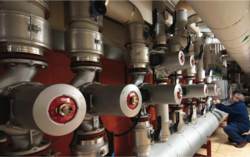Exploiting the potential of modern pumps

13 Biral pumps, including several from the low-speed range, have been installed as part of the overhauling of the plant room of Bury St Edmunds Sports & Leisure Centre, which was damaged by fire in 2004. The pumps supply constant-temperature heating to all the wet systems in the building, including the pool calorifiers, and primary hot water to the Hamworthy Powerstock hot-water heaters.
The low-speed Biral range is particularly suited to this application as the flat curves provide exceptional control without developing excess pressure in the system. Noise problems associated with large-volume circuits controlled by TRVs are eliminated.
PETER NEARS is concerned that the performance and energy-saving benefits of modern pumps are not fully exploited — especially with energy prices rising rapidly.In the last few years the market for pumps has developed from single speed to multi-speed. The progression has been from built-in invertor drives of various types up to the very latest permanent-magnet style of pump. These newest pumps can generate savings in electrical energy up to 70% compared with a conventional multi-speed pump. Looking back, we need to ask how many multi-speed pumps are ever set to the required speed, enabling them to deliver their energy-saving potential. I think most are left at maximum speed, wasting energy and adversely affecting boiler performance by narrowing the differential temperature across the boiler (typically 11 K with flow/return of 82/71°C). With condensing boilers becoming more common, the temperature differential is 20 K, which has a profound effect on pump requirements. Only about half the flow is required, reducing power consumption by about 75%, because of the pump laws. Strangely, system resistances are actually increasing and not decreasing. Why?
Escalating energy costs< In recent years, pipe diameters have been reduced to lower costs, which increases system resistance so a larger pump is needed. While pipework is a one-off capital cost, the larger pump is a cost borne by the building operator for the life of the system. We know that electrical energy costs are rising dramatically, so why is this practice continued? It certainly does not deliver best value. Changing from 50 mm steel tube to the next size of 65 mm reduces the pump power requirements by about a third. This, over the life of the system, represents considerable savings in energy for the end-user. Why not take the sensible view that does not leave the client paying additional running costs for 20 or 30 years? If pumps are not matched to system requirements, energy consumption will be higher than necessary and pump failure will definitely occur. Pumps should be selected at mid curve. An oversized pump draws excess current, runs very hot, and eventually the motor-winding insulation fails due to excessive heat.
Motor design The last few years have seen a huge increase in the number of electronic or variable-speed drives employed on heating pumps. Biral won an energy efficiency award seven years ago for its mini energy permanent-magnet pumps, which are the smallest domestic pumps, and consume as little as 5 W. Such major technological advances are not cheap and although all major manufacturers offer such products, we have to question if they being correctly utilised? As boiler manufacturers, we believe not. The concept of one pump fits all is wrong. We see many variable-speed pumps fitted to primary systems and even to calorifiers requiring a constant flow rate. What a waste of capital when a correctly sized multi-speed pump at half the price would do the job correctly. Biral has some new motor designs under development to further reduce electrical consumption. Details of these are still completely under wraps, which, considering the amount of money invested in research and development by companies, is not surprising news. The Biral mini energy P pump was field tested for five years before being released for sale; however you can be certain that investment in new technology to determine new levels of performance through continuous improvements will continue. The real issue in the UK is to stop treating pumps as commodity items, like tube and valves, and instead to treat the pump as the most important part of the hydraulic design.
Pump developments Pumps, such as Biral’s P range are particularly suited to today’s heating systems. They can reduce energy consumption by 30% at full load and up to 60% at partial load, and are ideal for secondary heating circuits that have weather compensation with variable flow. A built in inverter linked to the advanced permanent magnet motor technology gives total control and the ultimate in energy savings. Boiler primary circuits should use constant speed pumps to ensure adequate heat dissipation. At Hamworthy, we spend much time helping customers solve hydraulics problems and providing pump support for space-heating and hot-water systems. Understanding the pumps currently available would ensure they are used correctly to achieve energy and plant savings.
Peter Nears is product manager for Biral Pumps with Hamworthy Heating, Fleets Corner, Poole, Dorset BH17 0HH.
Related links:
Related articles:








